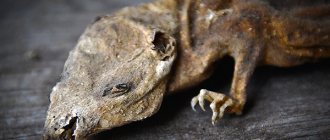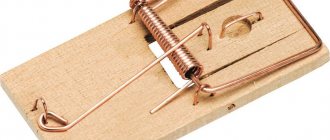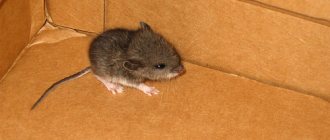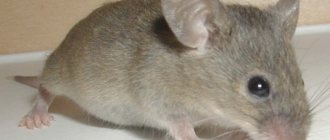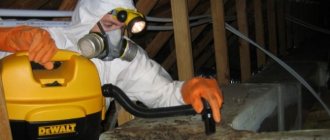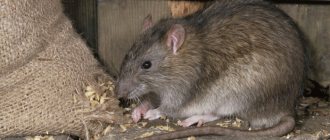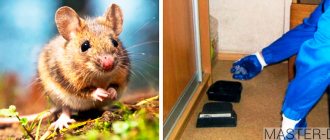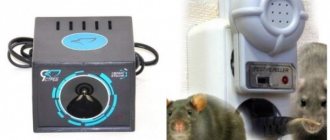Types of bait
Baits produced for rats and mice are divided into the following types:
grain mixtures; granular baits; soft briquettes; hard baits in briquettes; rodenticide foam.
In addition, gels are also produced, very similar to bait in briquettes, and powders, but inconvenient for use at home.
Anticoagulants are added to baits for mice and rats, which block blood clotting. As a result, after 3–7 days the death of the animal occurs. The delayed effect of the drug on the rodent body provides significant effectiveness:
they cannot determine the danger of what they eat and warn their brothers; There is no rejection, thus ensuring trouble-free effect.
The main thing for bait is to be tempting to the rodent, so manufacturers pay a lot of attention to the aroma and taste of the food. For this purpose, special substances are used that excite animal receptors. Flavors with the smell of chocolate, cheese and cream with vanilla are often added to the bait. In addition, the food is reliably protected from mold, it is stored for a long time without loss of quality and retains its good appearance.
Types of mouse traps
On sale you can find different mouse traps for mice, differing in their mechanism of action and the principle of catching rodents. These devices can be installed in different habitats of small animals, taking care that other inhabitants of the house do not get into them. Let's look at the main types of mouse traps that help quickly catch parasites.
Reusable store-bought mousetraps
A feature of reusable traps is that they return to their original form after the animal takes the bait from them. The advantage of such devices is their reusable use when catching a large number of mice. In this case, there is no need to replace its parts. In addition, purchased mousetraps are easy to care for, requiring only periodic cleaning and replacement of the “delicacy”.
The swing principle
Catching a mouse using the “swing principle” is very simple. This trap is an improved mousetrap, where a small bridge is installed above the container. Its construction requires a wide container of water with high walls. A beam capable of balancing is attached to it, and the latter is connected to a “ramp” installed on the floor.
The top plate is attached to the container with wire, so that under the influence of the weight of the rodent, the balancing bridge tilts. As a result, the animal falls into a container of water, where it drowns. After being triggered, the mousetrap returns to its original form. Thanks to such a simple and effective design, the trap is triggered many times during the night.
Spinning drum
Such a mousetrap is a freely rotating cylinder mounted on an axis, with baits attached to its sides. The installation is placed above the surface of a deep container (bucket), placing bridge boards to its edges. Having climbed onto the cylinder, the mouse tries to take the “delicacy” - it turns and the pest falls into the bucket. A bucket mouse trap can be installed both inside houses and inside outbuildings.
Trap
A cage with a door suspended by a thread is considered a trap. Inside such a mousetrap there is bait attached to a hook, which is attached to the opposite wall.
In the process of removing the treat with the mouse, the thread is released, which leads to the lowering of the door. So the mousetrap slams shut, and the animal remains inside it.
Another type of trap is a small box, the wire entrance to which looks like a tunnel. When the rodent gets inside, it begins to climb convenient vines. As a result, the mouse is unable to get back out, as it bumps into sharp wire ends.
Electric mousetrap
Electric mouse traps quickly shock the parasite that enters them with high-power electronic charges. As a result, the mouse dies instantly. These devices are powered by batteries or mains power. Some electric models have the following function:
- additional settings;
- storage of corpses (container);
- capture alerts (indicator).
Specialized stores have a large number of electronic mouse traps, varying in size, operating principle and price. The electric trap should not be placed in places with high humidity, since if water gets inside it, it will fail.
Important! The electronic trap operates on energy, and when it is turned off, its functionality stops.
Traps
A trap is a reusable trap that severely or fatally injures its victim. Inside this structure there is a treat, which lies on a special plane attached to quickly closing arcs. As soon as the rodent takes the bait, the trap slams shut, paralyzing the further movement of the victim.
For mice, it is worth purchasing smaller traps, otherwise catching them will be problematic. A rat, like a mouse, loves cleanliness and the presence of foreign odors can scare it away. Therefore, it is worth periodically washing the trap in a soda solution.
Glue traps
An effective way to control rodents is to use sticky traps. It is a small plate coated with a sticky compound (glue) that is non-toxic. Usually, “sticky mousetraps” are placed in places where rodents gather. During the day, several animals may stick to the surface.
The inconvenience of such a trap is the removal of stuck animals from its surface. This must be done with the help of additional devices, which often injure mice. An alternative way is to get rid of the stuck rodents along with the trap!
Important! You can make your own glue trap! You just need to purchase special mouse glue and apply it to dry surfaces where mice run. After some time, the parasites will be caught!
Homemade mousetraps
Self-made mousetraps that give visible results are in great demand among homeowners. The technology for their production is simple and improvised means are used for this. Let's look at different models of mousetraps that you can make yourself.
8 homemade mouse traps
From the bucket
An empty or half-filled bucket is an effective mouse trap! You can make such a device like this:
- A U-shaped frame is made from aluminum wire, the length of which is 10 cm greater than the diameter of the bucket. The width of the frame is 5 cm. Bend the closed end at an angle of 90 degrees, which will act as a lock.
- Circular turns are made around the nail on each of the two long sides of the U-shaped frame. They do it in the middle.
- A small rectangle is cut out of plastic, which would freely pass through the frame in length and width. It is desirable that its dimensions are 1.5 cm smaller than the dimensions of the U-shaped frame. A through hole is made in the middle of the rectangle through which a nail with an attached frame is inserted.
- A plastic lid with bait is attached to the open ends of the U-shaped frame.
- The finished structure is placed on a bucket filled with 5 cm of water. The trap is ready!
Important! So that the rodent can easily climb onto the bucket, a small plank is placed next to it.
From a plastic bottle
A plastic bottle can be an excellent mousetrap! To do this, a hole is made 7 cm from the base upwards so that a mouse can easily get in there. The bottle is attached to a load by its closed neck, and the bottle itself is placed ½ on the surface (table). A fragrant delicacy is placed inside the trap, which can lure the animals.
As soon as the mouse gets inside the bottle to the bait through the hole, the trap will slide off the surface and hang, attached to the load. The rodent will remain alive, awaiting its extraction.
Made of wood
This is a more complicated version of a homemade trap. To make it you need:
- wooden beam;
- cargo;
- snares (wire);
- hook;
- a thread;
- spring.
Holes are made in the prepared block for installing a snare (wire). The core of the tree is removed to form a U-shaped tunnel with several holes connected to a spring and thread that powers the entire installation. The bait is hung on the hook. When the mouse touches a tasty morsel, the lever activates and the structure slams shut.
Important! Wooden traps are not durable, as rodents can damage their walls.
Mousetrap from a jar
You can make such a trap using the following algorithm:
- A half-liter transparent glass jar is placed upside down on a flat surface where many rodents run around.
- A fragrant bait is placed under the prepared jar.
- The coin is placed on the edge under one of the sides of the jar so that the latter opens a little.
Through the resulting hole, the parasite will climb under the jar to the “delicacy” and touch the coin. The jar will completely tip over, trapping the animal in its captivity. It is problematic to extract a fast rodent through such a trap.
Paper trap
Take an A4 sheet and cut it with a cross from the center to the edges, not completely reaching them. The cut sheet is placed on a deep container, completely covering its diameter. A bait is hung above the paper, and a board is placed on the side so that the parasite can climb up.
When taking out a “treat,” the mouse lands on the center of the paper, which bends under its weight and the rodent falls into the container. The lightweight paper material regains its original appearance, so the trap can be used again.
Features of grain mixtures
Grain is the most common food for mice and rats. It is made using wheat or oats, and mixtures of grain crops are also possible. Highly effective, poisoned grain can cause death in a rodent if it eats the poison within one day.
Grain baits are also good because rats and mice drag grains into their holes, storing them for food. And there pregnant females and young shoots feed on these supplies, which leads to mass death of pests. Grain baits for rats and mice are used outdoors and indoors. They are laid out in small portions near water and in places where they are often present. In rooms with pets, it is better to use poison in bait houses.
Dog or cat food
It is known that rural and urban rodents are very different in their preferences. They choose the food that they were used to eating in childhood and which has the highest calorie content. Often this product is cat or dog food. Lard and sausage in the apartment are securely hidden in the refrigerator, but the pet’s bowl is in the public domain. Plus, pet food smells strong. Walking past it is a real challenge for a mouse.
Recipe from the Vredstop website: 1 oatmeal cookies, 3 corn sticks, 1 teaspoon of halva, 10 peeled seeds. Crush the mixture in a mortar and use it as bait for rats and mice.
Granular baits
Pellet baits work on the same principle as grain baits. The difference is that they are prepared from a special mixture containing grains, flour and sweets that rodents love, and then formed into granules. They are easy to eat and carry by rodents. They are used indoors and outdoors.
They do not crumble, do not get wet in water, do not succumb to mold, and remain attractive to pests for a long time. It is very important that granule baits are several times more effective than grain baits and more economical to use.
Lures in soft briquettes
Soft briquettes are a favorite treat and one of the best baits for rats. Rodents like doughy food, which they prefer to grains and eat it mostly entirely, and as a result their population is significantly reduced.
Soft baits also work well against mice. Within 4–6 days of use, rats are completely destroyed, and mice are destroyed by 90%. The briquettes contain the optimal dosage and are packaged in edible paper. They are easy to use, placed in certain places, and easy to monitor when eaten. The poison contains a bitter component that repels domestic animals.
Best mouse baits
Rodent fighters need to know what to put in a mousetrap as a tasty bait, because many smells both attract and repel mice.
The common belief that rodents love cheese is just a myth, since they only eat such a product if there is no other food nearby.
In nature, mice prefer grains such as rice and oats. However, rodents living at home can chew paper, soap, even candles. It is also possible to catch a mouse using bait such as dairy products, nuts, apples, and fragrant bread.
It is important not only to correctly place the device for catching rodents, but also to know which bait for mice is best.
Salted or smoked lard
Rodents love the smell of lard most of all, especially smoked lard. It is for this reason that this product is most often used to control mice. In order to attract the attention of the animal, you can even put a small piece of lard inside the mousetrap.
It is allowed to use fresh lard as bait, preferably smoked or slightly fried. It is not recommended to take an old product, since it will not only not help kill the rodent, but, on the contrary, will only scare it away.
Cold smoked fish
Another popular treat for many mice is cold smoked fish, which attracts rodents like a magnet. High quality fish is considered a prerequisite for successful fishing. When you place an old rotten product in a mousetrap, rodents usually avoid it.
Vegetable oil
The ideal solution when choosing bait for mice and rats is unrefined oil, which has a pleasant smell. You need to take a small bread crust, moisten it in sunflower oil, or dip a cotton wool into it. Most animals react positively to oil pressed from sesame seeds, but they still like sunflower oil much more.
Grains and baked goods
At any time of the year, rodents love to eat products such as flour and grain. If there are bags of such products in the pantry, uninvited guests first of all spoil them .
Today you can buy ready-made baits for fighting mice with the addition of poison in the form of grain. To catch the animal, you can mix flour with ingredients such as boric acid, poison or gypsum.
One of the best treats for pet rodents is baked goods, which emit a fragrant smell. Under such conditions, mice can hardly wait until the person leaves and becomes quiet. You can lure the animal to the mousetrap with the help of a bun, a crust of bread or fresh cookies.
However, it should be remembered that only fresh mouse bait is of interest. When using stale flour products, it is unlikely that you will be able to lure the animal to the trap, so such pieces will lie idle for a long time.
Regular white bread gives a good effect in catching pests. To enhance the effect, it is recommended to coat a small crust of this product with sunflower oil and place it in a trap.
Sausage
To solve the problem of which bait is best to put in a mousetrap, you can use smoked sausage. In fact, it attracts animals no less than lard. Rodent fighters say that with the help of such bait they can achieve good results when catching rats.
Unfortunately, today in the production of many sausages various flavors, chemicals, and flavor enhancers are used. Smart mice will rarely go for sausage that contains a small amount of natural ingredients.
Raw minced meat with onions
One of the favorite delicacies of rats is raw minced meat with the addition of onions, but this bait also works well when catching mice. Bait is considered the most common among those to which poison is added. To do this, make balls from minced meat and onions and distribute them in places where animals often run.
To prepare the bait, you need to take at least two parts of onion for 10 parts of minced meat; thanks to these proportions, it is possible to maintain a balance of flavors.
Cheese
Contrary to popular belief, most rodents do not like cheese. Only a smoked product can lure a mouse into a mousetrap, and only until its smell persists. It is allowed to use fresh homemade cottage cheese as a substitute for smoked cheese.
Rodenticidal foam
Rodent poison foam is contained in a pressurized container. When leaving it, it acquires a dense mass that does not lose its shape for a long time. This new type of bait has a double effect. It itself is poisonous, and when used, it fills all the cracks where rodents live. Having smeared themselves in it, the rats eat the toxic substance when cleaning their skins.
The poison is convenient because it can be used to coat pipes and walls, and when used, a person does not come into contact with it. The foam is applied directly into holes or onto substrates. It retains its shape for a long time and is readily eaten by rodents. Which bait is best to purchase largely depends on the place of application and the choice of the buyer.
Rating of the best rodent poisons
There are many different rodent poisons on the shelves of retail chains. What bait is best for rats? Here is the rating:
“Rat Death No. 1” - developed by a Ukrainian company. It is considered an effective and efficient long-lasting remedy. The product is highly toxic, so when using, you should strictly follow the instructions. The poison disrupts blood clotting, but in the first two days the animals do not experience discomfort and bring their relatives to enjoy the delicacies. The peak effect occurs on the seventh day. “Efa” – produced in the form of soft briquettes. The poison takes effect on the third day. Briquettes are convenient to lay out and control. The product does not release toxic substances for a long time, therefore it is recommended for use for preventive purposes. “Storm” is highly toxic and comes in the form of small granules with jagged edges that encourage the rodent to sharpen its teeth. The product is resistant to moisture and mold. Animals die on the sixth day. “Zookoumarin Neo” - consists of poisoned grains of bright color. The death of rodents occurs 3 hours after poisoning. Goliath is a new rat bait that is gaining popularity. Its uniqueness lies in the drying of corpses, which are subsequently burned. The effect occurs after 12 days. The poison is very toxic and is used only by professionals.
When choosing poison against rodents, you need to remember: the best of them acts slowly but effectively. When using, it is important to follow the instructions and destroy poisoned corpses in a timely manner.
Rat catching devices
Man is constantly improving methods of fighting rodents, and in addition to poisons, many different devices have been invented to catch the animal. All of them are divided into two types:
when caught, the rodent dies; the pest remains alive, but isolated.
Rat traps for the most part have a trap method of operation, which consists of triggering a spring device and tightly squeezing the animal between two plates or an arc and the base of the mechanism. The upper part of the structure is always metal, and the lower part is plastic, wood or metal. The device is used in residential and non-residential premises.
Conclusion
The fight against rodents due to their large numbers is a long process. During it, the following methods and devices are used:
- Traps - mechanical traps, electric containers, live traps, nets.
- Baits are prepared from flour, grains, seeds, lard, sausage, and eggs. Products are placed in traps in their pure form, or mixed with poison and placed along the passages of animals.
- To prevent mice from getting used to the bait, it is changed every three days.
- Food used as bait must be fresh. Pests will not be attracted to spoiled food.
Bait is important when catching rodents. It helps to lure animals into traps and clear the house of parasites.
Types of rat traps
There are various factory designs for catching rats and mice on sale, and they are also made by craftsmen. Here are some of them:
Mechanical rat traps are convenient and simply designed devices. During the night, depending on the device, up to 10 individuals are caught. Traps are reliable, but not very convenient. Homemade devices - there are a large number of different designs. Electronic is the most effective and convenient method of catching rodents.
What about cheese?
The idea that rats and mice love cheese most of all has spread thanks to cartoons. You can see a rodent chasing a cheese treat in Tom and Jerry, Chip and Dale, and Ratatouille. Perhaps a mouse with cheese looks more aesthetically pleasing than one with lard.
Be that as it may, real rodents don't like cheese. It is a myth. Of course, if the mouse is hungry, it may bite into a piece of cheese. But other baits work much more effectively.
If you decide to catch a mouse with cheese, use a smoked product. It attracts rodents much better.
What properties should the bait have?
When selecting bait for a mechanical rat trap, the following characteristics must be taken into account:
Smell. The rat should be attracted to the scent that is familiar to it, so that it consciously looks for the source of the treat, and does not end up there by accident. Type of treat. For bait, use only a product familiar to the animal. If it is left untouched for 2-3 days, then it is not suitable for a rat and requires replacement. Consistency. To trigger the trap's mechanical lock, the rat bait in the trap must be tightly constructed so that pulling on the bait will cause it to snap shut. When using bait with poison, its smell must be overwhelmed by the aroma of the food base. Size. Take bait of sufficient size so that it does not make the rat wary. Bait is usually prepared yourself using foods that rats like. But it is quite reasonable to use store-bought ones; they are sold in a large assortment.
Bait Products
Rats are omnivores and consume everything that is available in landfills. But they also have favorite foods, which they rush to, falling straight into a trap with bait. What do rats like:
Salo. Fresh pieces of smoked or salted product are used as bait for rats in a rat trap. Sausages. Having a good sense of smell, rats are able to distinguish additives in products and do not want to feast on cheap types of sausages. They like expensive smoked varieties. Vegetable oil. They soak bread and sometimes a cotton swab with it. Rodents love the smell of dark, unrefined sunflower, sesame or peanut oil. Grain and bread products. This is a favorite food of mice, but rats can also feast on such foods. Cheese. Fermented milk products are sometimes mistrusted by animals, but cheese is quite suitable as bait for rats.
All of these products are suitable for traps that have a mechanical interlock.
What bait is best to put in a mousetrap?
Before you start catching, you should decide what mice like and get to know their taste preferences. If food is of no interest to them, the trap will remain empty. Not every treat can be used as a trap.
In addition to taste, attention should be paid to the consistency of the product. It is important that it is tight. Then, if the mouse pulls the lever, the trap will close.
Interesting! In nature, food for mice is considered to be plant food (grains, vegetables), for rats it is animal food (meat, eggs). Therefore, it is better to lure small pests with grains. Rat - a piece of meat.
Salted or smoked lard
Lard is considered an effective bait for mice. They love the smoked product. To catch an animal, place a small piece of bacon in the trap. To improve its taste, it is better to fry it over an open fire.
On a note. It is better to plant a piece of bacon with a crust previously pierced with a nail. This way, the bait will sit more firmly in the trap mechanism.
You should put lard with streaks of meat in the mousetrap. A piece of white bacon does not emit a special odor, so it does not attract pests with its taste. To be sure that the trap will not work and he will run away, you can treat the product with a special poison. Then the animal will die from poisoning.
Vegetable oil
Sunflower oil attracts rodents with its aroma. Of course, putting it in its pure form to attract mice into a mousetrap will not work. Therefore, the product is used to process, for example, a piece of white bread.
If you don’t have one at home, you can use a piece of cotton wool treated with vegetable oil. Of course, you won’t be able to eat it, but it will help you fall into a trap. Of all types of vegetable oils, mice prefer sesame oil, which attracts them with its pungent odor.
Grains and baked goods
Freshly baked pastries are very fragrant. The rodent also loves it and comes to the smell. If you add bran and seeds, the effectiveness of using baked goods to catch pests increases.
The following types of whole grains are often poured in for profit:
- wheat;barley;buckwheat;rice.
Advice! To enhance the aroma, fresh baked goods should be treated with vegetable oil, preferably sesame oil.
Crumbs from fresh baked goods treated with liquid poison will help exterminate the pest. For glue traps, poison-treated pumpkin seeds, sunflower seeds, and small nuts are used.
Cold smoked fish
Any smoked meat attracts pests with its aroma. Fish is no exception. It is more convenient to use a cold-smoked product for bait, as it has a dense consistency and will hold tighter in the trap.
Only fresh fish should be used as bait. Rats will avoid low-quality, old, unsuitable food.
Sausage
Sausage is rarely used as bait for small rodents. Because this product contains many chemicals that the pest senses. If you don't have anything else on hand, you can use a piece of sausage.
It is better to pay attention to raw or smoked types of product. Rats respond well to homemade sausage. It is pointless to catch them using cheap types of meat products. Animals don't like them because of their smell.
On a note! A rat is more active in catching sausage than a mouse.
Cheese
The idea that rodents like cheese is considered a misconception. These animals are indifferent to him. They don't like fermented milk products. Mice will pay attention to this bait if there are no other, more tasty foods nearby.
An exception is smoked sausage cheese, which attracts pests with its characteristic smell. You can make it more fragrant by mixing it with sesame oil. Regular cheese dries out quickly and does not attract rats.
Raw minced meat with onions
The option with raw minced meat is more suitable for rats. Since they are carnivores, they eat meat. But mice will not bypass him either. To attract rodents and make the aroma more pronounced, it is recommended to add onions. The main thing is to keep it in moderation.
Place two parts of finely chopped onion on 10 parts of minced meat. This bait is easily diluted with poison. But minced meat has a significant disadvantage: it spoils quickly. The musty product repels mice and rats.
If there are animals and children in the house, then the use of toxic chemicals is prohibited.
